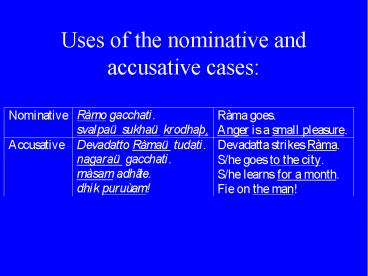Uses of the nominative and accusative cases: - PowerPoint PPT Presentation
Title:
Uses of the nominative and accusative cases:
Description:
Uses of the nominative and accusative cases: Adpositions governing the accusative: Accusative forms of the personal pronouns: Gender: Usually, males are denoted by ... – PowerPoint PPT presentation
Number of Views:38
Avg rating:3.0/5.0
Title: Uses of the nominative and accusative cases:
1
Uses of the nominative and accusative cases
2
Adpositions governing the accusative
3
Accusative forms of the personal pronouns
4
Gender
- Usually, males are denoted by masculine nouns
(e.g. nara- man', masc.) and females by feminine
nouns (e.g. strã- woman', fem.) the gender
assigned to nouns denoting sexless things has no
clear semantic basis. - There are, however, some fairly reliable
correlations between a noun's gender and the form
of its stem. e.g. stems in a are generally
masculine and neuter, while stems in long vowels
are mostly feminine.
5
Short-a stem declension asva- horse' (masc.)
6
Short-a stem declension dàna- gift' (neut.)
7
The ten classes of present-tense stems
8
Characteristics of the four thematic classes
- 1. The stem always ends in a.
- 2. The stem doesn't exhibit vowel- grade
alternations.
9
Characteristics of the four thematic classes
- 3. In an open syllable, the stem-final a
lengthens before any ending beginning with m or
v thus, there is no lengthening before -m in
the 1st person singular imperfect active.
10
Characteristics of the four thematic classes
- 4. The stem-final a is dropped before all
endings beginning with e. - 5. The 2nd person singular imperative active is
simply the stem.
11
Characteristics of the four thematic classes
- 6. The optative suffix is -ã- before consonants
and -ãy- before vowels. By sandhi, - a- -ã- ? e
- a- -ãy- ? ey .
12
Stem formation in the thematic classes
- 1st class (bhå- class)
- stem root a-
- ?
- guõa, if possible
13
Stem formation in the thematic classes
- 6th class (tud- class)
- stem root a-
- ?
- zero grade
14
Stem formation in the thematic classes
- 4th class (div- class)
- stem root ya-
- ?
- unchanged
15
Stem formation in the thematic classes
16
Irregularities in stem formation in the thematic
classes
17
Irregularities in stem formation in the thematic
classes
18
Irregularities in stem formation in the thematic
classes
19
Irregularities in stem formation in the thematic
classes
20
Irregularities in stem formation in the thematic
classes
21
Irregularities in stem formation in the thematic
classes
22
Active inflectional endings for thematic verbs
(conjugations 1, 4, 6, 10) in the present system
23
Active inflectional endings for thematic verbs
(conjugations 1, 4, 6, 10) in the present system
24
Active inflectional endings for thematic verbs
(conjugations 1, 4, 6, 10) in the present system































